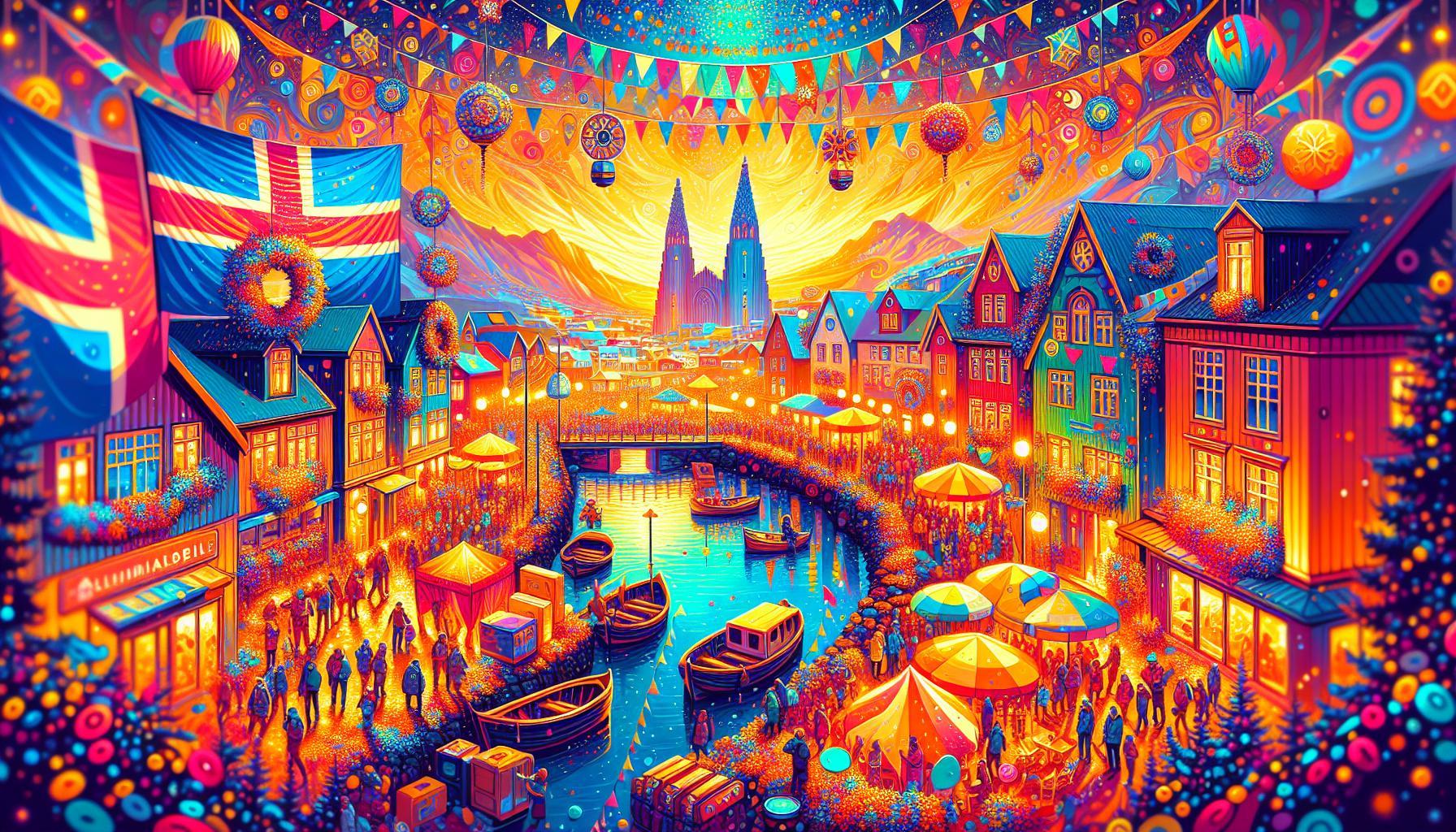Planning a trip to Iceland can feel daunting with its reputation for high costs, but understanding the true price of travel can transform your experience. This comprehensive budget breakdown will help you navigate accommodation, dining, and activities, enabling you to enjoy Iceland’s breathtaking landscapes without breaking the bank. Discover essential tips to make your dream vacation a reality!
Understanding Iceland’s Cost of Living: What You Need to Know
When planning a trip to Iceland, many travelers are often caught off guard by the stark contrast between the breathtaking natural beauty and the associated costs of living. It’s not just the stunning landscapes that will leave a mark on your heart; you’ll also need to navigate the financial realities of this Nordic paradise. Understanding the cost dynamics can make or break your Icelandic adventure, helping you budget effectively while still enjoying all that this unique destination has to offer.
Key Expenses in Iceland
Several factors contribute to Iceland’s high cost of living, which matches its status as one of the most expensive countries in the world. Here are some primary expenses to anticipate:
- Accommodation: Hotel prices can vary significantly based on the season, location, and type of lodging. In popular areas like Reykjavik, expect to pay upwards of $200 per night for mid-range accommodations.
- Food: Dining out is another area where costs can add up quickly, with meals at restaurants often exceeding $25 to $50 per person. For those looking to save, consider cooking your meals, as grocery stores provide an affordable alternative.
- Transportation: Rental cars are a common choice for exploring the island, though be prepared for rates around $30 to $70 per day, depending on the vehicle and insurance coverage.
- Activities: Excursions to natural sites, such as the Golden Circle or whale watching tours, can range from $70 to $200, making pre-booking essential to stay within budget.
Budgeting Tips for Your Visit
To maximize your experience while keeping expenses manageable, consider these practical budgeting tips:
- Plan Ahead: Research and book accommodations and tours in advance to lock in better rates.
- Eat Smart: While splurging on Iceland’s culinary scene can be tempting, opting for local supermarkets can help balance your food budget. Dishes like pylsur (Icelandic hot dogs) offer tasty yet inexpensive meal options.
- Use Public Transportation: To save on travel costs, utilize Reykjavik’s efficient public transport system or share rides with fellow travelers.
- Take Advantage of Free Attractions: Iceland is home to numerous stunning natural landscapes, many of which are completely free to enjoy. National parks, waterfalls, and hiking trails can provide unforgettable experiences without the hefty price tag.
Understanding Iceland’s cost landscape through practical insights from budget breakdowns will enable you to enjoy your journey while being mindful of your wallet. With the right preparation and awareness of prices, you can create lasting memories in this enchanting land without falling into financial distress.
Accommodation Options: From Budget Hostels to Luxury Hotels
Traveling through Iceland is a feast for the senses, but before you dive into the breathtaking scenery, it’s essential to consider where you’ll lay your head at night. The range of accommodation options in Iceland caters to all budgets, ensuring that every traveler can find something that suits their needs—be it cozy hostels, comfortable guesthouses, or extravagant hotels. With a mix of traditional charm and modern luxury, you’re bound to find a place that enhances your visit while keeping within your budget.
Budget-Friendly Accommodations
If you’re looking to explore Iceland without breaking the bank, hostels and guesthouses are excellent options. Many travelers recommend using platforms like Hey Iceland to find reliable self-catering accommodation that doesn’t compromise on quality. In Reykjavik, for instance, you can find dormitory-style hostels starting as low as $30 per night, particularly during the off-peak seasons. These budget accommodations often provide communal kitchens, allowing you to save on meal costs as well. Here’s a quick look at some popular budget accommodations:
- Hostels: Ranging from $30 to $80 per night depending on the season and location.
- Guesthouses: Typically $50 to $100, offering a homey feel and breakfast options.
- Campsites: Perfect for adventurers—expect prices around $20 to $40 per night.
Mid-Range Lodging
For those willing to spend a bit more, mid-range hotels and boutique accommodations provide a cozy retreat after a long day of exploration without the high costs associated with luxury stays. Options like the Reykjavik EDITION blend style with comfort, offering rooms that are both aesthetically pleasing and equipped with modern amenities. Prices in this category hover around $150 to $300 per night, making them a popular choice for travelers looking to balance comfort with cost.
Luxury Experiences
If indulgence is what you seek, Iceland does not disappoint. Luxury hotels such as the renowned Hotel Borg or the stunning ION Adventure Hotel provide top-tier service and breathtaking views, often featuring spas and fine dining options. Prices can range from $300 to over $600 per night, depending on the season and room type. These accommodations often offer unique experiences such as private tours, gourmet meals, and access to exclusive areas for viewing the Northern Lights.
| Type of Accommodation | Price Range (per night) | Key Features |
|---|---|---|
| Hostels | $30 – $80 | Shared rooms, communal kitchens |
| Guesthouses | $50 – $100 | Home-cooked breakfasts, cozy environments |
| Mid-Range Hotels | $150 – $300 | Modern amenities, stylish decor |
| Luxury Hotels | $300+ | High-end service, exceptional views |
Each type of accommodation presents a unique opportunity to experience the beauty and culture of Iceland. Whether you choose a budget-friendly hostel to meet fellow travelers or a luxury hotel to enjoy privacy and comfort, your choice in lodging plays a significant role in shaping your adventure through this remarkable country. Balancing your accommodation choices with your spending strategies will help you navigate the question posed in “How Expensive is Iceland to Visit: Complete Budget Breakdown” effectively, allowing you to make the most out of your trip without compromising on the experience.
Dining in Iceland: Balancing Local Flavors and Budget-Friendly Meals
Dining out in Iceland offers an intriguing blend of local flavors and a unique culinary experience, yet it can prove to be a challenge for budget-conscious travelers. The cost of food in Iceland is notably high, largely due to its geographical isolation and dependence on imported goods. Even a simple meal at a mid-range restaurant can leave a dent in your wallet, typically costing between 3,500 – 4,500 ISK (approximately $25 – $30 USD) per person, making it crucial to strategize your dining choices while still indulging in the rich gastronomy of the region [[2]].
To make the most of your dining experiences without busting your budget, consider these practical strategies:
Tips for Budget Dining in Iceland
- Lunch Buffets: Many restaurants offer lunch buffets at set prices, allowing you to sample a variety of traditional dishes at a fraction of the dinner price. This can be both a cost-effective and delicious way to explore local cuisine.
- Grocery Stores: Stocking up on groceries from local stores can significantly reduce your food expenses. Prepare simple meals or snacks during your trip. Iceland’s supermarkets offer various items, including ready-to-eat meals.
- Happy Hours: Look for happy hour deals at bars and restaurants which often feature significantly reduced prices on food and drinks.
- Street Food: Explore local street food options, which can provide an authentic taste of Icelandic cuisine without the high cost associated with sit-down dining.
While indulging in fine dining is an excellent way to celebrate your trip, it’s essential to be aware that a single upscale meal can rack up costs quickly. For instance, dining averages around $910 for two people over multiple meals, with some splurges reaching hefty price tags like $50 for a pizza [[3]]. However, by balancing your dining options and being mindful of when and where you eat, you can enjoy the best of Iceland’s culinary offerings while keeping your budget intact.
In summary, navigating the dining landscape in Iceland requires a bit of planning and flexibility. By leveraging budget-friendly tips and being strategic about when to indulge, you can savor the essence of Iceland’s local flavors without overspending. Through careful budgeting and exploration of diverse dining venues, including high-quality dining, casual cafes, and local markets, you can make your culinary journey through this beautiful country both memorable and affordable.
Transportation in Iceland: Navigating Between Adventures
Iceland’s breathtaking landscapes are a treasure trove for adventurers, but navigating between its stunning sites can significantly influence your travel budget. Understanding the transportation options is crucial when considering how much a trip to this Nordic paradise will set you back. From the rugged Ring Road to the vibrant streets of Reykjavik, getting around Iceland can be both an adventure and an expense.
Transportation Options
Traveling across Iceland offers various modes of transportation, each catering to different budgets and travel styles. Here are some popular choices:
- Rental Cars: One of the most flexible ways to explore Iceland is by renting a vehicle. Daily rental prices range from $40 to $100, depending on the type of car and season. It’s worth noting that exploring off the beaten track often requires a 4WD, especially if you plan to visit the highlands.
- Public Buses: For budget travelers, public buses provide an economical way to reach popular destinations. The Strætó bus service covers many routes, and tickets vary in price based on distance—typically starting around $3.
- Guided Tours: If you prefer a more structured adventure, many companies offer guided tours that include transportation. These generally range from $100 to $300 per day, depending on the itinerary and inclusions.
- Taxis and Rideshares: While convenient, taxis are among the most expensive ways to travel in Iceland, with fares starting at about $10 plus $2 per kilometer.
Budgeting for Transportation
When planning your budget for transportation in Iceland, consider the overall costs based on your itinerary. A mid-range traveler might expect to spend around $250 per day for accommodations, food, and activities, with transportation accounting for a significant portion of this budget. Here’s a simple breakdown of estimated daily transportation costs:
| Transportation Type | Daily Cost |
|---|---|
| Rental Car | $40 – $100 |
| Public Bus | $10 (for multiple trips) |
| Guided Tour | $100 – $300 |
| Taxi (One-way trip) | $10 – $50 |
By carefully considering your transportation options and budgeting accordingly, you can maximize your Icelandic adventure without overspending. Whether it’s the freedom of a rented car or the affordability of public transportation, each choice can lead you to unforgettable experiences and picturesque locations throughout this stunning country.
Activities and Attractions: Affordable Experiences for Every Traveler
In a land marked by breathtaking landscapes and unique cultural experiences, Iceland offers travelers a plethora of activities and attractions that won’t break the bank. For those concerned about budget while seeking adventure, the good news is there are many affordable experiences that allow you to explore this magnificent country without compromising on enjoyment.
Natural Wonders on a Budget
Iceland’s natural beauty is its biggest draw, and fortunately, many of its stunning landmarks can be enjoyed at little to no cost. Consider embarking on a self-drive tour along the renowned Golden Circle, which features iconic sights such as the Þingvellir National Park, Geysir Geothermal Area, and the majestic Gullfoss Waterfall. Entry to these locations is free, so you can appreciate the grandeur of Icelandic nature while keeping your travel costs low.
Explore the rugged coastlines and volcanic landscapes, and take a hike in places like Landmannalaugar or Skaftafell, where trails of varying lengths lead to mesmerizing views and hidden waterfalls. The best part? Most of these hiking experiences are free, allowing you to immerse yourself in the natural beauty of Iceland without spending a dime.
Cultural Insights and Local Experiences
In addition to stunning landscapes, Iceland offers a rich cultural tapestry that can be explored affordably. Many towns and villages, such as Reykjavik, host free walking tours led by passionate locals. These tours provide insights into Iceland’s history, architecture, and modern culture, offering a valuable experience at no cost. Alternatively, visiting cultural landmarks such as the National Museum of Iceland or the Reykjavik Art Museum usually entails a reasonable entry fee, making them accessible options for those wishing to delve deeper into Icelandic heritage.
For a taste of local life, consider checking out farmer’s markets or local food festivals, where you can sample traditional dishes without spending a fortune at restaurants. This not only supports local businesses but also allows you to engage with the community in a more personal way.
Thrilling Activities That Keep Costs Down
Adventure enthusiasts can enjoy a range of adrenaline-fueled activities without overspending. There are free or low-cost options for exploring Iceland’s unique geology, such as glacier walking or visiting the numerous hot springs scattered throughout the countryside. For instance, while popular thermal pools like the Blue Lagoon charge higher admission, many natural hot springs, including the Secret Lagoon, provide a more affordable alternative for relaxation amidst beautiful surroundings.
For the wildlife lovers, spots like Jökulsárlón Glacier Lagoon offer chances to see seals and unique bird species—activities which generally require no entry fee. Combining low-cost attractions with the spectacular scenery makes for memorable experiences without the hefty price tag often associated with traveling in Iceland.
Embrace the exceptional natural beauty and rich cultural heritage of Iceland through these affordable experiences, allowing you to explore the country’s offerings while maintaining your budget. From hiking majestic trails to enjoying local art and culture, adventure awaits without the financial burden typically associated with international travel.
Seasonal Pricing: How to Time Your Visit for Maximum Value
Timing your visit to Iceland is crucial for maximizing your travel budget and experiencing the country’s spectacular landscapes without breaking the bank. Iceland’s tourism price fluctuations follow seasonal patterns that can significantly affect costs, from airfare to accommodations and even dining. Understanding these trends can empower you to choose the best time for your Icelandic adventure, ensuring you enjoy incredible experiences without overspending.
Choosing the Right Season
The peak tourist season in Iceland generally runs from June to August, coinciding with warm weather, long days, and a host of festivals. During this period, flights and hotel prices can soar, often nearing 30% higher than during off-peak times. Conversely, visiting in the shoulder seasons—late spring (May) and early autumn (September)—can yield substantial savings. Prices for flights and accommodations typically drop by 20-25%, allowing budget-conscious travelers to enjoy much of Iceland’s beauty with fewer crowds.
To give you a clearer picture, here’s a breakdown of average costs during different seasons:
| Season | Average Round-Trip Flight Cost (USD) | Accommodation (per night, USD) | Activity Costs (per day, USD) |
|---|---|---|---|
| Summer (June – August) | $800 – $1200 | $200 – $400 | $150 – $250 |
| Shoulder (May, September) | $600 – $900 | $150 – $250 | $100 – $200 |
| Winter (October – April) | $500 – $800 | $100 – $200 | $80 – $150 |
Special Deals and Packages
In addition to pricing trends based on seasons, keep an eye out for special deals. Many airlines offer discounted flights during the winter months, compensating for the cold weather with lower prices. Moreover, many accommodations offer off-season rates to attract visitors in the colder months, making it an excellent time for travelers who don’t mind bundling up.
Booking activities in advance can also save you money. Tours, especially popular ones like the Golden Circle or Northern Lights excursions, often provide early-bird discounts or package deals if you book multiple activities at once. This could help mitigate some of the typically higher costs associated with activities during peak season.
In summary, aligning your travel dates with Iceland’s seasonal pricing can play a pivotal role in managing expenses. By considering the time of year and actively seeking out discounts, you can enjoy the breathtaking landscapes and unique cultural experiences Iceland has to offer without overstretching your budget.
Tips for Saving Money in Iceland: Smart Strategies for Budget Travelers
Iceland dazzles with its stunning landscapes and unique experiences, yet it’s notorious for being one of the pricier travel destinations. However, with some strategic planning and smart choices, travelers can save a significant amount of money while still enjoying all that this incredible country has to offer. By implementing these budget-conscious strategies, you can make your visit more wallet-friendly without sacrificing the adventure and excitement.
Utilize Budget Accommodation
Staying in hostels or guesthouses can drastically reduce your accommodation costs. While a private room in a hostel averages around $150 per night, booking dormitory beds can be even cheaper. For those traveling in groups, consider renting a private apartment or Airbnb, which could further lower the cost per person.
- Search for hostels or campgrounds for budget-friendly options.
- Travel during the off-peak season to find lower rates.
- Consider alternatives like staying with locals through platforms like Couchsurfing.
Smart Dining Choices
Eating out in Iceland can quickly inflate your travel budget. Instead of dining in restaurants for every meal, opt for affordable dining alternatives. Many local eateries offer hearty lunch buffets where you can sample a variety of Icelandic dishes for a fixed price, often significantly lower than dinner menus.
- Cook meals if you have access to a kitchen; grocery stores like Bonus and Kronan are popular among locals.
- Try street food or food trucks for unique yet inexpensive meals.
- Take advantage of happy hour deals at bars and restaurants.
Transportation Tips
While renting a car offers flexibility, it can be expensive when considering fuel and insurance. Instead, look into public transportation options, which are generally more budget-friendly, especially for longer stays.
- Use buses for intercity travel or consider day passes for local transport.
- Carpool with other travelers to split rental and fuel costs.
- Join guided tours that include transportation to popular sights.
By employing these strategies, you can navigate the common financial pitfalls of visiting Iceland. Many budget-conscious travelers have successfully balanced experiencing the country’s natural beauty while enjoying local culture without overspending, making it feasible to explore Iceland without breaking the bank. With these tips in mind, you’re now equipped to make informed financial choices on your adventure in this stunning part of the world.
Currency and Payments: What to Expect When Spending in Iceland
When traveling to Iceland, understanding the currency and payment systems can significantly impact your experience and budgeting. The official currency of Iceland is the Icelandic króna (ISK), and while it is always prudent to check the latest exchange rates, as of now, 1 USD is approximately equal to 1000 ISK, providing a useful frame of reference for your spending. The prices for goods and services can be surprisingly high compared to other destinations, which underscores the importance of planning your finances accordingly as part of your overall budget breakdown for visiting Iceland.
One of the most convenient aspects of spending in Iceland is the widespread acceptance of credit and debit cards. In fact, you can use cards for nearly every transaction, from shopping at local stores to paying for meals at restaurants and even at gas stations. This means that carrying large amounts of cash is not necessary, making it easier for travelers to manage their budgets on the go. It is advisable, however, to inform your bank of your travel plans in advance to avoid any issues with card transactions during your trip.
For those times when cash might be needed—such as in rural areas where card acceptance may be limited—it’s practical to withdraw Icelandic króna at ATMs. The Keflavik Airport is a convenient spot for this, allowing you to start your journey with cash in hand for unforeseen expenses or tips. Ensure to consider any ATM fees and check with your bank about international transaction fees to avoid unexpected costs.
In terms of practical payment tips, keep in mind that small businesses, particularly outside Reykjavik and Akureyri, might prefer cash in some instances. Thus, it’s always a good idea to have some local currency available. Here’s a quick rundown of what to expect in terms of payments:
| Payment Type | Common Use |
|---|---|
| Credit/Debit Cards | Widely accepted in urban areas, restaurants, shops, and hotels. |
| Cash (ISK) | Useful for small purchases, rural areas, and personal transactions. |
| Mobile Payment Apps | Increasingly accepted, particularly among younger demographics. |
Overall, navigating the monetary landscape in Iceland doesn’t have to be daunting. By being prepared with knowledge of the currency, understanding the prevalence of card transactions, and having cash on hand for emergencies, you can focus more on enjoying the stunning landscapes and unique culture, rather than worrying about your budget.
Q&A
How expensive is Iceland to visit?
Iceland is considered one of the more expensive travel destinations in Europe, with average daily costs ranging significantly based on travel style. Expect to spend between 8,000-10,000 ISK for a dorm bed in a hostel and 27,000-31,000 ISK for a basic double room.
Costs can vary depending on factors such as seasonality, accommodation choice, and dining preferences. For example, a coffee can cost between 650-800 ISK, while a simple sandwich ranges from 650 to 1,800 ISK [[1]].
What are the average accommodation costs in Iceland?
Accommodation in Iceland can range widely. Budget travelers can find dorms starting at 8,000 ISK, while hotels typically range from 27,000 ISK to 43,000 ISK per night for a double room.
If you prefer more privacy, self-catering apartments or Airbnbs start at around 20,000 ISK and can go up considerably. Booking in advance often helps secure better rates [[3]].
Can I visit Iceland on a budget?
Yes, it is possible to explore Iceland on a budget! Utilizing hostels, self-catering options, and public transport can help manage costs effectively.
Many visitors find that cooking their own meals is a great way to save money, as dining out can be quite expensive. Plus, using public transport or hitchhiking offers affordable travel options while allowing you to meet locals [[2]].
What is the cost of food in Iceland?
Food prices in Iceland can be steep. A meal in a casual restaurant generally costs around 3,000-4,000 ISK, while groceries for a week can vary from 15,000 to 30,000 ISK depending on your dietary needs.
For the most budget-friendly experience, consider visiting supermarket chains like Bonus or Kronan and stocking up on essentials. Dining out should be reserved for special occasions to better manage your budget.
Why does Iceland have such high prices?
Iceland’s high prices are primarily due to its remote location, which increases import costs, and its small population, leading to limited competition for goods and services.
Additionally, the country’s unique geography and climate demand specific infrastructure and logistics, which also contribute to the overall cost of living and travel. Understanding these factors can better prepare travelers for their budget planning.
How much does transportation cost in Iceland?
The cost of transportation in Iceland varies based on your mode of travel. A public transport ticket in Reykjavík costs about 630 ISK, while car rental rates can range from 10,000 ISK per day upwards, depending on the vehicle.
For those planning to explore the countryside, renting a car is often the best option, but bear in mind that fuel prices can be high. Opting for buses can also provide a cheaper way to see the stunning landscapes while saving on expenses.
Can I save money by traveling during the off-season?
Yes, traveling during the off-season can significantly reduce costs. Accommodations and flights tend to be cheaper, with discounts often available.
Visiting between late September and early November, or March to May, allows you to experience Iceland’s beauty with fewer tourists and lower prices. Just be prepared for varying weather conditions and shorter daylight hours!
Key Takeaways
As you wrap up your exploration of Iceland’s budget landscape, it’s clear that this stunning island offers a variety of options to suit every traveler’s wallet. From cozy dorm beds in bustling Reykjavík to scenic self-catering apartments that let you cook up local delicacies, the range of accommodations ensures comfort without breaking the bank. Imagine sipping freshly brewed coffee at a quaint café as you people-watch, with prices ranging from 650 to 800 krónur, or enjoying a delicious sandwich while soaking in the unique atmosphere of this vibrant culture.
Remember, while Iceland can feel pricey, clever planning allows for unforgettable experiences without the hefty price tag. Whether you’re wandering through the otherworldly landscapes of Thingvellir National Park or indulging in local stories shared by friendly shopkeepers, there’s a rich tapestry of adventures awaiting you.
So pack your bags and prepare to discover the majestic beauty and warm hospitality of Iceland! Dive deeper into your journey and explore more tips and tricks that can help you experience the wonders of this incredible destination, ensuring every moment is both memorable and within reach. Happy travels!






